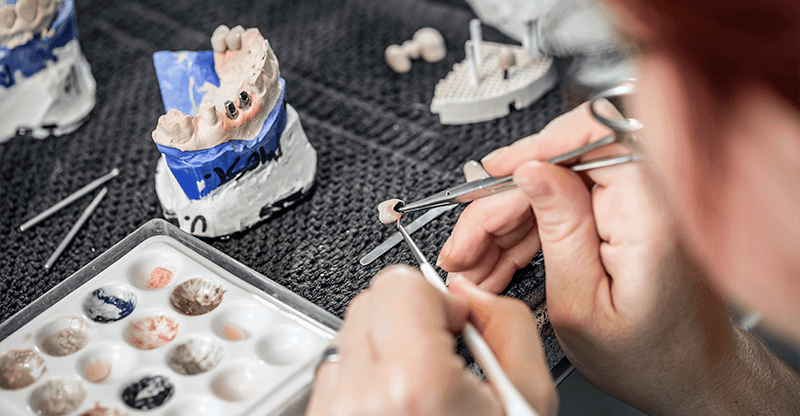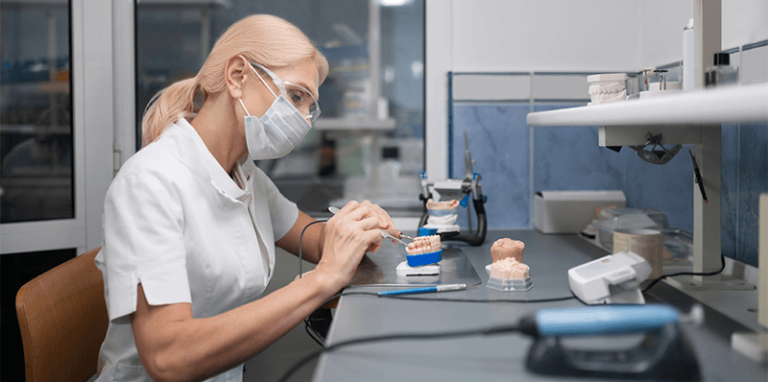Startseite » Veneers production

Last posts
You want prettier teeth?
Request an appointment now and learn more about treatment with veneers.
Veneers production
Veneers production is an important process that requires a lot of attention to detail. Veneers are popular due to their beautiful and natural appearance. They are wafer-thin veneers (0.3-1 mm) that the doctor applies to the teeth with a special adhesive. Only the best dental technicians are able to produce suitable veneers in dental laboratories. Good quality is very important, especially since the veneers must last up to 20 years.
In this article, you will therefore learn everything you need to know about the production of veneers.

Table of contents
How are veneers made?
The dental technicians in their dental laboratories are working in close cooperation with the dentist. The production process always depends on the dental impressions of the patient made by the dentist. In most cases, the production process looks like this:
- First impression: After an initial consultation, the dentist makes an impression of the patient's teeth. This impression is then sent to the dental laboratory. The laboratory then creates a so-called mock-up, which the dentist then uses.
- Mock-up: The mock-up is a model that gives the patient the opportunity to see what they might look like with veneers. To do this, the laboratory first creates a plaster model. From now on, the dental technician will recreate the teeth on this model with a layer of wax. He then forms the reconstructed model with a kneadable molding compound and precisely registers all corrections and additions. The laboratory then sends the finished plastic mass to the dentist, where the patient can examine the mock-up.

- Grinding: As soon as the patient has finally decided on veneers, the dentist grinds off a thin layer of teeth This can vary greatly from patient to patient. After grinding, the dentist sends another impression of the now ground teeth to the dental laboratory. Meanwhile, the patient and doctor determine the right tooth color with the help of different sample colors.
- Production of the veneers: First, the dental technicians create a model from the impression that they can work with.The veneers are individually adjusted on the model until they have exactly the right shape. The veneers preparation can take 4 to 10 working days. When all veneers are finished, the dental technician sends the manufactured veneer shells to the dentist.
- Bonding: Now the dentist uses the adhesive technique to bond the finished veneers to the patient's teeth.
Laboratory production
Veneers are manufactured in a dental laboratory. It usually takes a few weeks for the veneers to be ready. First, an impression of the dentition is made. This impression is sent to the laboratory, where the production of the veneers then begins. To cover the time, the dentist uses so-called mock-ups, which the patient can wear in the meantime.
The experts in the laboratory ensure that the veneers are perfectly matched to the dentition and have exactly the right shape and size. Once the veneers are ready, they are fitted to the teeth and attached.
Veneers materials
In general, it can be said that traditional ceramic veneers are the best option. They are usually between 0.3 and 1 mm thick. The ceramic used for their manufacture is tooth-colored, translucent, highly resilient, has a long service life and is well tolerated..

“With ceramics, it’s possible for the dental technician to layer better and thus work more accurately and qualitatively.”- Muhammed Ferit Kiziler, dentist, founder of Inno-Esthetics & specialist in veneers
The dental technician can use the material to perfectlyimitate the surface structure as well as the color of the natural tooth. In addition, the good tolerance of the ceramic by patients is another advantage.
Furthermore, there are no known allergies or reactions with other materials. The veneers have almost the same hardness and abrasion resistance as natural teeth. Unlike the natural tooth, little plaque can accumulate on the smooth surface of the ceramic veneer.
Over time, two methods have become established as laboratory processes for the fabrication of conventional veneers.
-
Veneers with pressed ceramic core: The wafer-thin veneers are pressed from a glass-ceramic core. The dental technician then applies the final natural color to this ceramic core. The paint consists of a veryfine ceramic mass. After application, the heat in an oven permanently bonds the color to the glass-ceramic core.
The more expensive, but higher-quality variant means that each glass-ceramic core is layered separately with ceramic. The laboratory effort is higher, but this means that even more individual results can be achieved.
- Veneers, directly layered from ceramic: In this method, the dental technician layers the veneers directly from ceramic. This layering requires a great deal of effort and, accordingly, a higher price.
Non-Prep Veneers
Another type of veneers are non-preps (without preparation) veneers. They are made of composite, a mixture of plastic, quartz and glass.
However, the difference from others is not only in the material, but also in the bonding. Instead of grinding and preparing the tooth, as is the case with conventional veneers, the dentist places the veneers directly on the tooth. The fabrication of non-prep veneers is time-consuming, so only an experienced dental technician should do it. In addition, a qualified dentist should bond them.


